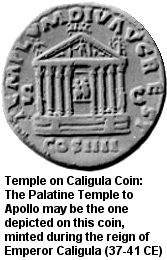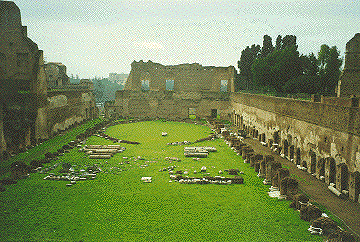October 9: Christianity vs Paganism
Temple of Apollo Dedicated (28 BCE),
Christianity v. Paganism
 It was on this date, October 9, 28 BCE, that the Temple of Apollo was dedicated on the Palatine Hill in Rome. The "Apollo Palatínus" was built by Emperor Augustus and contained a library. As Platner describes it,
It was on this date, October 9, 28 BCE, that the Temple of Apollo was dedicated on the Palatine Hill in Rome. The "Apollo Palatínus" was built by Emperor Augustus and contained a library. As Platner describes it,
This temple was the most magnificent of Augustus' buildings, constructed of solid blocks of white Luna marble, and the doors were decorated with reliefs in ivory, one representing the rescue of Delphi from the Celts, and the other the fate of the Niobids. Before the entrance to the temple stood a marble statue of the god, and an altar surrounded by four oxen by [5th cent. BCE sculptor] Myron. In the cella was a statue of Apollo by Scopas [also 5th cent. BCE], one of Diana by Timotheus [5th cent. BCE], and of Latona by Cephisodotus [mid-4th century BCE].*
That this magnificent temple no longer exists – it was burned down on 18 March 363 – is a tragedy to art and to scholarship, but also characteristic of the Christian attitude toward pagan culture. Suffice it to say that the Muslim attitude toward non-Muslim culture, as evidenced by the Taliban's destruction of Buddhist statuary in Afghanistan (February 2001), is far from an aberration and shows a similar attitude.**
That the Christianity of fourth-century Rome laid the foundation for the glories of Western civilization, taught morals to the pagans, ended slavery, spread education and built hospitals, are the chief claims of apologists for the new religion. And every claim is historically false. For sure, the doctrinal fight of Christians against the Jews and Gnostics was an edifying example to the pagans. And the general immorality of the members of the new religion – which the bishops were trying to have enforced by imperial law – was condemned by Chrysostom and Gregory of Nyssa in the East, and Augustine in Africa, in most severe language.
Trying to sell Christian morality to the pagans was akin to marketing a derelict as a dandy. The pagans would have smiled, had not they been subjected to many decades of violence and persecution before the "triumph" of the Church. It was neither the high character of the Christians nor their doctrines that won pagans over to Christianity. They were converted by force. The Theodosian Code initiated the persecutions.
In fact, as soon as Constantine was dead, the bishops found (that is, forged) a decree imposing "condign punishment" on all who sacrifice to the gods. The forged decree became law and was renewed, sometimes expressly including the death-sentence, in 345, 350, 381, 383, 386, and 391. It was necessary to renew the decree repeatedly, over half a century, because the pagans refused to give up their religion!
The pagan temples had been looted of their artistic and literary treasures, and closed, between 380 and 390. Necessary, perhaps, in order to stamp out competition, but that's where the pagans housed their hospitals. And pagan education was forbidden, even though the Christians had no replacement for it. Consequently, the Romans, who had been about 90 percent literate at this point, became at least 90 percent illiterate as the school system collapsed.
Paganism might have been replaced with something better, or at least something original. Instead, the Christians who had exterminated paganism were in fact adopting paganism into Christianity! The Church borrowed its Holy Week and Christmas celebrations, its paraphernalia of worship – vestments, candles, incense, altars, hymns, statues of virgin and child – and so on from the suppressed rival religions. Even the Christian doctrine of immortality was borrowed from Platonism, Manichaeism, and the cults of Mithra and Isis!
So even if Apollo, God of the sun, was crushed by God and his Son, it was always a conquest, never a conversion.
* from Aedes Apollinis Palatini by Samuel Ball Platner (as completed and revised by Thomas Ashby), "A Topographical Dictionary of Ancient Rome." London: Oxford University Press, 1929.
** "All we are breaking is stones," said Mulla Mohammad Omar, a Taliban Islamic militia leader, prior to the destruction, in the central province of Bamiyan, of the tallest Buddha figure in the world, created in the 3rd century A.D. He went on, "The breaking of statues is an Islamic order and I have given this decision in the light of a fatwa of the ulema (clerics) and the supreme court of Afghanistan. Islamic law is the only law acceptable to me."
Originally published October 2003 by Ronald Bruce Meyer.


